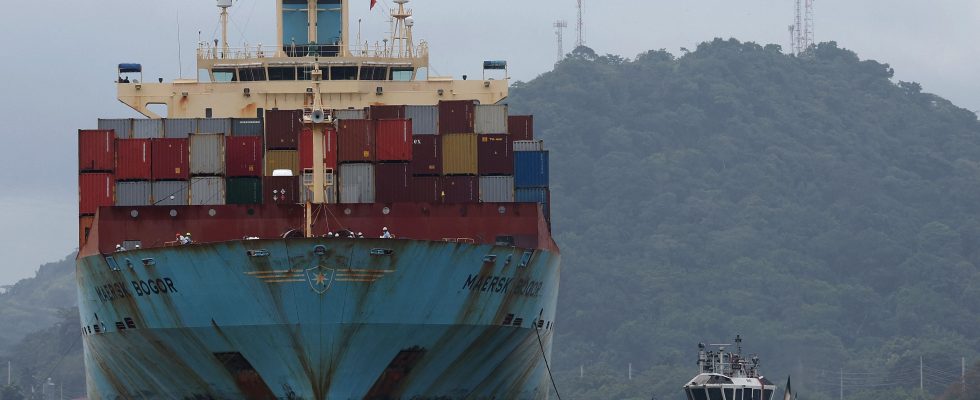Very expensive bid. On Wednesday November 8, Japanese oil giant Eneos Holding spent 3.7 million euros to secure the passage of one of its ships through the Panama Canal, according to the tender documents. Its tanker will be able to use the corridor on November 15. The amount is historic. But it might not stay that way for long: the previous record – 2.67 million – only lasted a short week… The big companies no longer hesitate to take out their checkbooks to guarantee themselves a place on this navigation route between the Atlantic and the Pacific and avoid a long queue – up to more than 160 boats in August! Because the Panama Canal, through which 6% of global maritime trade passes, has been suffering the consequences of climate change for several months.
“The month of October was the driest recorded in 73 years. The drought caused by the El Niño phenomenon continues to severely impact the reservoir systems”, that is to say the two artificial lakes which provide water. fresh water needed to operate the locks, the Panama Canal Authority (ACP) said. However, this basin also supplies drinking water to half of the country’s inhabitants. To cope with the lack of rain, the operator limited the draft and further reduced the number of crossings, after a first restriction this summer: 25 ships daily since November 3, 20 by mid-February 2024. Half as much as the daily average last year.
The drought in Panama highlights the vulnerability of certain trade routes to climate change. The case is not isolated: in the summer of 2022, nearly 3 million tonnes of goods could not be transported across a dry Rhine. Same problem for Mississippi, in the United States. “All river canals are concerned,” confirms Éric Foulquier, lecturer in geography at the University of Western Brittany. “This poses a problem because the river is a solution for the transition, an alternative to the road.” Ports are also concerned about their future, like that of Rotterdam (Netherlands), the largest in Europe, threatened by rising sea levels.
Rising costs
“I don’t think there will be any major upheavals in maritime routes,” says Camilo Umana-Dajud, economist at the Center for Prospective Studies and International Information (CEPII). But we will see a general increase in costs per year. the adaptations of companies to new regulations on greenhouse gas emissions, and by increasing insurance premiums.” With ever more intense typhoons and cyclones, crossings can indeed be more risky, and container losses more frequent.
To avoid the current bottleneck that the Panama Canal has become, options exist in the short term: the boat-train-boat combination to connect the two oceans or bypassing the continent to the south. That’s three or four weeks of additional travel. Other canal projects to compete with that of Panama vaguely emerged a few years ago, notably in Nicaragua. “They were stillborn,” says Hervé Baudu, professor at the National Maritime School and member of the Marine Academy. “More generally, shipowners will have to anticipate better, even if it is very difficult to make projections on the recurrence of such a drought over time,” he adds.
The companies could then prefer, depending on the destination of the goods, to deport part of the ships to the other major world canal, Suez, which connects the Mediterranean to the Indian Ocean. Around 13,000 boats circulate there per year. “And there are no local weather phenomena that could disrupt its operation,” notes Hervé Baudu. The congestion of this strategic axis could only come, in his eyes, from an obstruction of the canal by a ship, as with the Ever Given in 2021. In this scenario, the bypass of the south of Africa at the Cape of Good Hope is a suitable alternative route, but longer and therefore more expensive.
Polar routes, bad track
Some covet another path: the North Pole. Russian giant Gazprom announced in September that it had delivered liquefied natural gas (LNG) to China for the first time via the Arctic and the Northeast Passage, which is more easily navigable due to global warming. Should we really count on the ice melting in the coming decades? “To believe that new routes are emerging there is to know very little about maritime transport,” says Éric Foulquier. “I always thought that people were too optimistic about this aspect,” agrees Camilo Umana-Dajud.
The economist lists two pitfalls: geopolitical tensions with Russia, and the consequent cost of these new routes – use of icebreakers and higher insurance. “Other factors mean that they are not competitive with existing routes, such as being open only 3 or 4 months per year, and with a low volume compared to Suez,” adds Hervé Baudu. The current infrastructure network also makes a global revolution in maritime commercial traffic difficult. “This poses an industrial problem: we would have to change the places where goods are loaded and unloaded,” notes Éric Foulquier. For containers, the system works thanks to the density of the port network. Going from Rotterdam to Shanghai faster only has little interest; it’s the stops along the way that count. However, there are none on the Arctic route.”
In view of the climatic, and therefore global, challenges that weigh on the poles, the prospect of seeing tankers and other container ships cutting through the ice there hardly enchants the experts. “If we find a perspective on the Arctic, it will not be good news for the world,” concludes Éric Foulquier.
.
